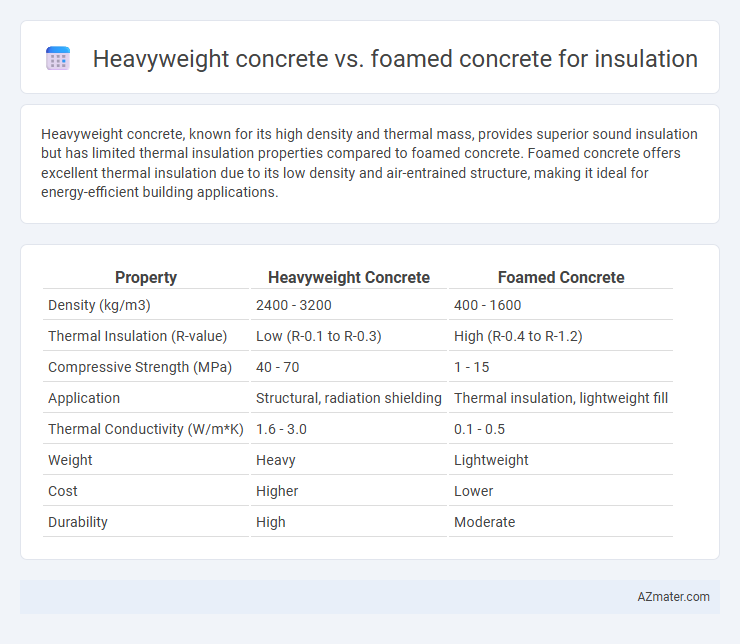Heavyweight concrete, known for its high density and thermal mass, provides superior sound insulation but has limited thermal insulation properties compared to foamed concrete. Foamed concrete offers excellent thermal insulation due to its low density and air-entrained structure, making it ideal for energy-efficient building applications.
Table of Comparison
| Property | Heavyweight Concrete | Foamed Concrete |
|---|---|---|
| Density (kg/m3) | 2400 - 3200 | 400 - 1600 |
| Thermal Insulation (R-value) | Low (R-0.1 to R-0.3) | High (R-0.4 to R-1.2) |
| Compressive Strength (MPa) | 40 - 70 | 1 - 15 |
| Application | Structural, radiation shielding | Thermal insulation, lightweight fill |
| Thermal Conductivity (W/m*K) | 1.6 - 3.0 | 0.1 - 0.5 |
| Weight | Heavy | Lightweight |
| Cost | Higher | Lower |
| Durability | High | Moderate |
Introduction to Heavyweight and Foamed Concrete
Heavyweight concrete, characterized by its dense aggregates such as barytes or magnetite, offers superior radiation shielding and high thermal mass, making it ideal for environments requiring substantial insulation and structural strength. Foamed concrete, produced by mixing cement paste with stable air bubbles, provides excellent thermal insulation capabilities due to its low density and high porosity, significantly reducing heat transfer. Both materials serve distinct insulation roles: heavyweight concrete excels in load-bearing and radiation protection, while foamed concrete is valued for lightweight applications and energy-efficient thermal insulation.
Composition and Material Properties
Heavyweight concrete is composed primarily of dense aggregates such as barite, magnetite, or hematite, resulting in high compressive strength and excellent radiation shielding properties but limited thermal insulation due to its density. Foamed concrete incorporates a significant volume of air bubbles generated by foaming agents, yielding a lightweight material with low thermal conductivity and superior insulation performance but reduced structural strength. The material properties of heavyweight concrete emphasize durability and load-bearing capacity, whereas foamed concrete prioritizes thermal insulation and energy efficiency in building applications.
Thermal Insulation Performance
Foamed concrete provides superior thermal insulation compared to heavyweight concrete due to its high air content, which significantly reduces thermal conductivity. Heavyweight concrete, with its dense aggregate composition, has a higher thermal mass but lower insulation capability, making it less effective in minimizing heat transfer. The choice between the two depends on balancing structural strength requirements against energy efficiency goals in building design.
Structural Strength Comparison
Heavyweight concrete, composed of dense aggregates like barite or magnetite, offers superior structural strength and load-bearing capacity compared to foamed concrete, making it ideal for high-stress applications such as nuclear shielding and heavy foundation work. Foamed concrete, characterized by its low density and high porosity due to air bubbles, provides excellent thermal insulation but has significantly lower compressive strength, typically ranging between 1 to 8 MPa. The choice between heavyweight and foamed concrete depends on balancing the need for thermal insulation versus structural performance, with heavyweight concrete preferred for strength-critical structures and foamed concrete for lightweight, insulating applications.
Density and Weight Implications
Heavyweight concrete, with a density typically above 2400 kg/m3, provides superior structural strength but results in increased weight, impacting load-bearing requirements and transportation costs. Foamed concrete, characterized by a much lower density ranging from 400 to 1600 kg/m3, offers excellent thermal insulation properties while significantly reducing structural load and improving ease of handling. The choice between heavyweight and foamed concrete depends on balancing insulation needs with weight limitations in construction design.
Fire Resistance and Safety Aspects
Heavyweight concrete offers superior fire resistance due to its dense composition and high thermal mass, effectively slowing heat transfer and maintaining structural integrity during fires. Foamed concrete, while lightweight and providing good thermal insulation, has lower fire resistance and may degrade faster under high temperatures, posing potential safety concerns. Choosing heavyweight concrete ensures enhanced fire safety in buildings requiring robust fire protection measures.
Acoustic Insulation Capabilities
Heavyweight concrete, composed of dense aggregates like barite or magnetite, offers superior soundproofing by effectively blocking airborne noise through its high mass and density. Foamed concrete, characterized by its lightweight and porous structure, provides sound absorption by dissipating sound waves within its cellular matrix but generally offers lower sound transmission loss compared to heavyweight concrete. For acoustic insulation, heavyweight concrete excels in reducing sound transmission, making it ideal for environments requiring robust noise control, whereas foamed concrete suits applications needing sound absorption alongside thermal insulation.
Durability and Longevity
Heavyweight concrete exhibits superior durability and longevity due to its dense aggregate composition, making it highly resistant to wear, impact, and environmental factors such as freeze-thaw cycles. Foamed concrete, while offering excellent thermal insulation and lightweight properties, generally has lower compressive strength and is more susceptible to cracking and moisture ingress over time. The selection between heavyweight and foamed concrete depends on the required balance between insulation efficiency and structural durability for the specific application.
Cost Efficiency and Economic Considerations
Heavyweight concrete has higher material and transportation costs due to its density, making it less cost-efficient for insulation compared to foamed concrete, which utilizes lightweight aggregates and air bubbles to reduce expenses. Foamed concrete enhances thermal insulation while lowering structural loads, leading to savings in foundation costs and long-term energy bills. Economic considerations favor foamed concrete for large-scale insulation projects due to its affordability, ease of application, and improved energy efficiency over heavyweight alternatives.
Application Suitability and Usage Scenarios
Heavyweight concrete offers superior radiation shielding and high compressive strength, making it ideal for nuclear facilities, medical imaging rooms, and heavy structural foundations. Foamed concrete excels in thermal insulation and lightweight fill applications, commonly used in roof insulation, void filling, and non-load bearing partitions where reduced weight and soundproofing are priorities. Selecting between these depends on project requirements such as load capacity, thermal performance, and environmental conditions.

Infographic: Heavyweight concrete vs Foamed concrete for Insulation
 azmater.com
azmater.com